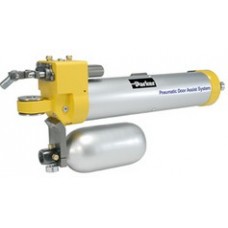|
How does it work?
Pneumatic DAS uses a smart design, drawing energy created by the compressor that operates automatically within the vehicle. It has functionality for remote actuation, enabling a high level of precision movement control. This fail safe solution allows occupants to quickly and safely exit the vehicle with two simple motions.
Is Pneumatics a Viable Option for Armoured Vehicles?
Let's take a closer look at some of the misconceptions about pneumatic systems used in MRAP vehicle door applications:
Misconception #1: Weight
Q: Can pneumatic systems help manufacturers optimize vehicle design?
A: The Parker Pneumatic DAS is efficient, lightweight and innovatively designed without the need for extra parts or accessories. It allows more of the vehicle's payload capacity to be used for armor making it a flexible design option.
Misconception #2: Force
Q: Can air actually create enough force to open the MRAP door?
A: Pneumatic cylinders impart force by converting the potential energy of compressed gas into kinetic energy. Within the cylinder, the compressed gas expands due to its pressure being greater than the atmospheric pressure. This expanding air moves a piston in a desired direction transferring force and performing work.
Misconception #3: Control & Safety
Q: MRAP vehicles encounter enemy attack and must operate through rough, wet terrain. They can be rolled over and damaged. For the safety of the soldiers, the armored doors which protect them during an assault, must not hinder them as they try to escape from the vehicle. Soldiers must be able to precisely control and easily repair these doors. What control options does a pneumatic system offer?
A: If an MRAP vehicle unit finds itself in an emergency, they need to be able to assess the situation quickly and gain control. Parker Pneumatic DAS is well-equipped to protect its occupants with:
- Damping and locking for complete door control
- No electrical components
- Fail safe design
- Silent operation
- High pressure pneumatic emergency system
|


